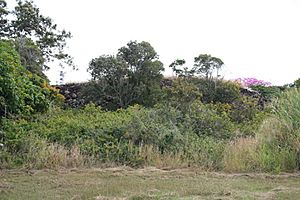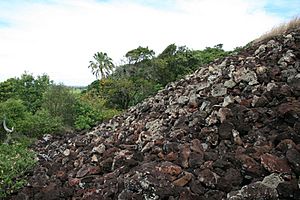Sir Anthony's Rest facts for kids
Quick facts for kids Sir Anthony's Rest |
|
|---|---|

Sir Anthony's Rest, 2009
|
|
| Location | Sir Anthony's Rest Street, Qunaba, Bundaberg Region, Queensland, Australia |
| Design period | 1870s - 1890s (late 19th century) |
| Built | 1888 |
| Built for | Vice-Regal visit |
| Official name: Sir Anthony's Rest | |
| Type | state heritage (built) |
| Designated | 23 February 2001 |
| Reference no. | 602053 |
| Significant period | 1880s (fabric) 1880s (historical) |
| Lua error in Module:Location_map at line 420: attempt to index field 'wikibase' (a nil value). | |
Sir Anthony's Rest is a special lookout point in Qunaba, Bundaberg Region, Queensland, Australia. It is built from dry stones, meaning no cement was used to hold them together. This lookout was created in 1888 for a very important visitor: Sir Anthony Musgrave, who was the Governor of Queensland at the time.
The lookout is located on top of a hill called the Bundaberg Hummock. From here, you can see amazing views of the surrounding Bargara canefields. Sir Anthony's Rest is now protected as a heritage site, added to the Queensland Heritage Register on 23 February 2001.
Contents
History of Sir Anthony's Rest
Sir Anthony's Rest is a platform made of dry stones and rubble. It was built in 1888 when the Governor of Queensland, Sir Anthony Musgrave, visited Bundaberg. This visit was part of his tour of the area. At that time, Bundaberg was celebrating 21 years since its first non-Indigenous settlement.
William Gordon Farquhar, who owned the Hummock sugar plantation, built this lookout. He used the help of South Sea Islander labourers. The lookout faced east, offering great views over the sugar cane fields of the Shire of Woongarra. It was built on the highest point in the area, known as the Sloping Hummock.
The Sloping Hummock Hill
The Sloping Hummock is a small hill that was once a volcano. It is about five kilometres south of Mon Repos beach. In 1799, Lieutenant Matthew Flinders saw this hill from his ship, HMS Norfolk. He was exploring the waters between Fraser Island and the mainland. Flinders named it the Sloping Hummock during his visit.
Bundaberg's Sugar Industry
The sugar industry grew quickly in Bundaberg. One of the first sugar plantations was Millaquin, started in 1882. Other plantations like Hummock, Oakwood, and Spring Hill followed in 1883. William Gordon Farquhar's land was called the Hummock because it included part of this famous hill.
By the end of 1882, Farquhar had planted 154 hectares of sugar cane. His juice mill machinery arrived in May 1883. The first sugar crushing happened on June 30, 1883.
Farquhar later sold his plantation to HJ Rhodes. But Farquhar stayed involved and lived at the Hummock until he died in 1909. The Hummock plantation stopped crushing sugar in 1893. It then joined with a nearby plantation called Windermere.
Farmers in the Woongarra area often struggled to make a living from growing corn. But the sugar industry changed everything. The Millaquin Sugar Refinery was built between 1880 and 1882. This made sugar farming much more profitable. Many small crushing mills were built on farms. The sugar juice was then sent to the refinery.
Between 1882 and 1884, 24 crushing mills opened in the Bundaberg area. Many of these were in the Woongarra Shire. Farmers eagerly switched to growing sugar cane. They often relied on workers from the South Sea Islands to help clear the land and work in the cane fields.
South Sea Islanders had been working on sugar plantations in the Bundaberg area since the mid-1870s. They were brought directly to Bundaberg starting in 1879. Before that, planters got Islanders through Maryborough, where the sugar industry began earlier.
The Governor's Visit
Sir Anthony Musgrave was the Governor of Queensland from 1883 to 1888. He was very popular and often toured different towns. He wanted to learn about as much of the colony as possible. Musgrave visited northern ports and inland towns in 1883, 1884, 1887, and 1888. People always welcomed him warmly.
Musgrave was born in Antigua in 1828. He served as Governor of South Australia and then Governor of Jamaica before coming to Queensland. He arrived in Queensland in November 1883. He was keen on the idea of Australian Federation, which meant the different Australian colonies joining together.
Governors' tours were very important in early Queensland. They were both practical and ceremonial. The local newspapers reported on them in detail. These tours helped communities feel connected and showed off their progress. They also gave people a chance to tell the Governor about local issues.
Governor Musgrave and his wife, Lady Musgrave, visited Bundaberg on May 30-31, 1888. This was the first official visit from a Queensland Governor in ten years. They arrived on the government steamer Lucinda.
During their visit, the Vice-Regal party (the Governor and his group) toured the Millaquin Plantation and drove around Bundaberg. On their second day, they went out of town. They had lunch at Mon Repos. A special part of their tour was arranged at the Hummock. William Gordon Farquhar had set up a special resting spot at the highest point. A small shelter, surrounded by rocks, was built there. Here, they enjoyed refreshments. The view from this spot was considered the best in the area, looking out over the cane farms. Reports from that time said both the Governor and Lady Musgrave loved the beautiful scenery.
How Sir Anthony's Rest Was Built
William Gordon Farquhar likely started using South Sea Islander labour when his plantation began in 1883. Many plantation owners believed that South Sea Islanders were essential for field work. This included clearing stumps and rocks to prepare the land for planting sugar cane.
Rocks were often broken into smaller pieces. They were then loaded onto carts and taken to the edges of the farm. There, they were used to build stone boundary fences. These fences were usually about one and a half metres high and just over one metre wide.
Local stories say that wooden sleds, pulled by horses, were used to collect rocks. As the land was cleared, rocks were placed on the sleds. Large rocks were broken up with hammers. These pieces were then put into corn bags, carried by two Islanders, and added to the sled. Once full, the sleds were unloaded at the end of the field.
The way Sir Anthony's Rest was built is similar to other dry-stone walls in the area. For example, the South Sea Islander Wall at Mon Repos was built in a similar way. These walls were made in layers, with bigger stones on the outside and smaller stones filling the middle. This building method was common in the Woongarra area.
Usually, special structures built for governors' visits were only temporary. But the platform for Sir Anthony's visit was made to last. This makes Sir Anthony's Rest a rare example of a permanent structure linked to a governor's tour.
Description of Sir Anthony's Rest
Sir Anthony's Rest is located in a sugar cane field in an area known as "The Hummock." This is about five kilometres east of Bundaberg. The Hummock is a well-known landmark in the region.
The site offers wide views towards Bundaberg, the nearby town of Bargara, and the surrounding cane fields. It is a platform made of dry earth and stone rubble. It is about 4 to 5 metres high, 40 metres long, and 35 metres wide. The platform covers about 0.1 hectare of the twenty-hectare cane farm.
Near the platform, on the north-east side, there is a large fig tree, mango trees, and other old plants. There are no signs left of the original shelter that was built for the Governor's visit. The rest of the property is still used for growing sugar cane.
Why Sir Anthony's Rest is Important
Sir Anthony's Rest was added to the Queensland Heritage Register on 23 February 2001 because it meets several important criteria:
It shows how Queensland's history developed. Sir Anthony's Rest is important because it is connected to a key historical event: Governor Sir Anthony Musgrave's visit in June 1888. This visit happened during the growth of the Bundaberg and Woongarra region.
It shows rare or uncommon parts of Queensland's culture. Sir Anthony's Rest is special because it is one of the few physical reminders of a governor's tour. Most shelters built for visiting governors were only temporary.
It has important aesthetic value. The platform is about 40 metres long, 35 metres wide, and 4 to 5 metres high. It is a clear landmark that can be seen from the Bagara-Bundaberg Road.
It has a strong connection to a community or cultural group. Sir Anthony's Rest is very important to the local South Sea Islander community today. It reminds them of their ancestors' experiences in Queensland. It also holds strong social meaning for the people of Bundaberg and the surrounding areas. The community values it highly.
It is connected to important people or groups in Queensland's history. Sir Anthony's Rest is important because of its link to the South Sea Islander community. It represents the significant work of this large group of workers. They played a huge role in developing the sugar industry in the Bundaberg district, which was one of the richest sugar areas in the state during the late 1800s and early 1900s.


